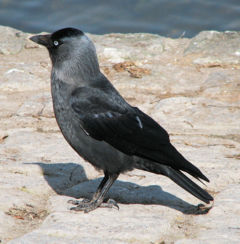
Western Jackdaw
Background Information
SOS Children produced this website for schools as well as this video website about Africa. Click here for more information on SOS Children.
- This article is about the species Corvus monedula, sometimes known as the Eurasian Jackdaw. For the species Corvus dauricus of eastern Asia, see Daurian Jackdaw (the European and Daurian Jackdaw together form the subgenus Coloeus). For other uses, see Jackdaw (disambiguation).
| Jackdaw | |
|---|---|
 |
|
| Conservation status | |
|
Least Concern
|
|
| Scientific classification | |
| Kingdom: | Animalia |
| Phylum: | Chordata |
| Class: | Aves |
| Order: | Passeriformes |
| Family: | Corvidae |
| Genus: | Corvus |
| Species: | C. monedula |
| Binomial name | |
| Corvus monedula (Linnaeus, 1758) |
|
 |
|
| Jackdaw range | |
The Jackdaw (Corvus monedula), sometimes known as the Eurasian Jackdaw or European Jackdaw, is one of the smallest species (34–39 cm in length) in the genus of crows and ravens.
Description
Most of the plumage is black or greyish black except for the cheeks, nape and neck, which are light grey to greyish silver. The iris of adults is greyish white or silvery white, the only member of the genus outside of the Australasian region to have this feature. The iris of juvenile jackdaws is light blue. The bird is sociable, moving around in pairs (male and female) or in larger groups, though the pairs of birds stay together within the flocks.
Distribution and habitat
Jackdaws are found over a large area stretching from North West Africa through virtually all of Europe, Iran, north-west India and Siberia, where they inhabit wooded steppes, woodland, cultivated land, pasture, coastal cliffs and villages and towns.
Behaviour
Diet
The jackdaw mostly takes food from the ground but does take some food in trees. It eats insects and other invertebrates, weed seeds and grain, scraps of human food in towns, stranded fish on the shore, and will more readily take food from bird tables than other Corvus species.

Nesting
Jackdaws usually nest in colonies in cavities of trees, cliffs or ruined and sometimes inhabited buildings, usually in chimneys, and even in dense conifers. Eggs, normally 4-5, are incubated for 17-18 days and fledge after 30-35 days.
Voice
The voice is a "tchak-tchak" or "kak-kak" call.
Social behaviour
Konrad Lorenz studied the complex social interactions that occur in groups of jackdaws and published his detailed observations of their social behaviour in his book King Solomon's Ring. To study jackdaws, Lorenz put coloured rings on the legs of the jackdaws that lived around his house in Altenberg, Austria for identification, and he caged them in the winter because of their annual migration away from Austria. His book describes his observations on jackdaws' hierarchical group structure, in which the higher-ranking birds are dominant over lower ranked birds. The book also records his observations on jackdaws' strong male–female bonding; he noted that each bird of a pair both have about the same rank in the hierarchy, and that a low-ranked female jackdaw rocketed up the jackdaw social ladder when she became the mate of a high-ranking male.
Jackdaws have been observed sharing food and objects. The active giving of food is rare in primates, and in birds is found mainly in the context of parental care and courtship. Jackdaws show much higher levels of active giving than documented for chimpanzees. The function of this behaviour is not fully understood, although it has been found to be compatible with hypotheses of mutualism, reciprocity and harassment avoidance.
Jackdaws in culture and custom
In some cultures, a jackdaw on the roof is said to predict a new arrival; alternatively, a jackdaw settling on the roof of a house is an omen of death and coming across one is considered a bad omen.
Popular culture
In The Pearls of Lutra, Ninian's Church is infested with jackdaws, and some kill a young mousemaid named Piknim.
In " Someplace to be Flying", by Charles de Lint, one of the main animal-people characters, Jack, is a jackdaw. His character is the 'story-teller' of the animal-people and is depicted as compassionate, sharing and influential. All of these characters are observed in the actual habits of jackdaws.
Popular author Ken Follett has a book titled Jackdaws, set in France and England in the World War Two years.
In Gilbert and Sullivan's HMS Pinafore (1878), beginning the song "Things Are Seldom What They Seem" the character Buttercup sings, "Things are seldom what they seem, Skim milk masquerades as cream; Highlows pass as patent leathers; Jackdaws strut in peacock's feathers."
In the fifth stanza of Edward Lear's The Jumblies, the Jumblies "...bought a pig, and some green jackdaws, and a lovely monkey with lollipop paws".
In Shakespeare's Othello, "But I will wear my heart upon my sleeve for daws to peck at..."
In Milan Kundera's The Book of Laughter and Forgetting, Kundera notes that Hermann Kafka, father to Franz Kafka had a sign in front of his shop with a jackdaw painted next to his name, since kavka means jackdaw in Czech.
Pink Floyd's Roger Waters references a jackdaw in his song "Flickering Flame".
In several stories from Aesop's Fables the jackdaw is referenced. Such stories are: " The Jackdaw and the Doves," " The Eagle and the Jackdaw," " The Escaped Jackdaw," " The Eagle, the Jackdaw and the Shepherd," and " The Jackdaw and His Borrowed Feathers" (which Gilbert and Sullivan's " HMS Pinafore" references in the song "Things Are Seldom What They Seem").
